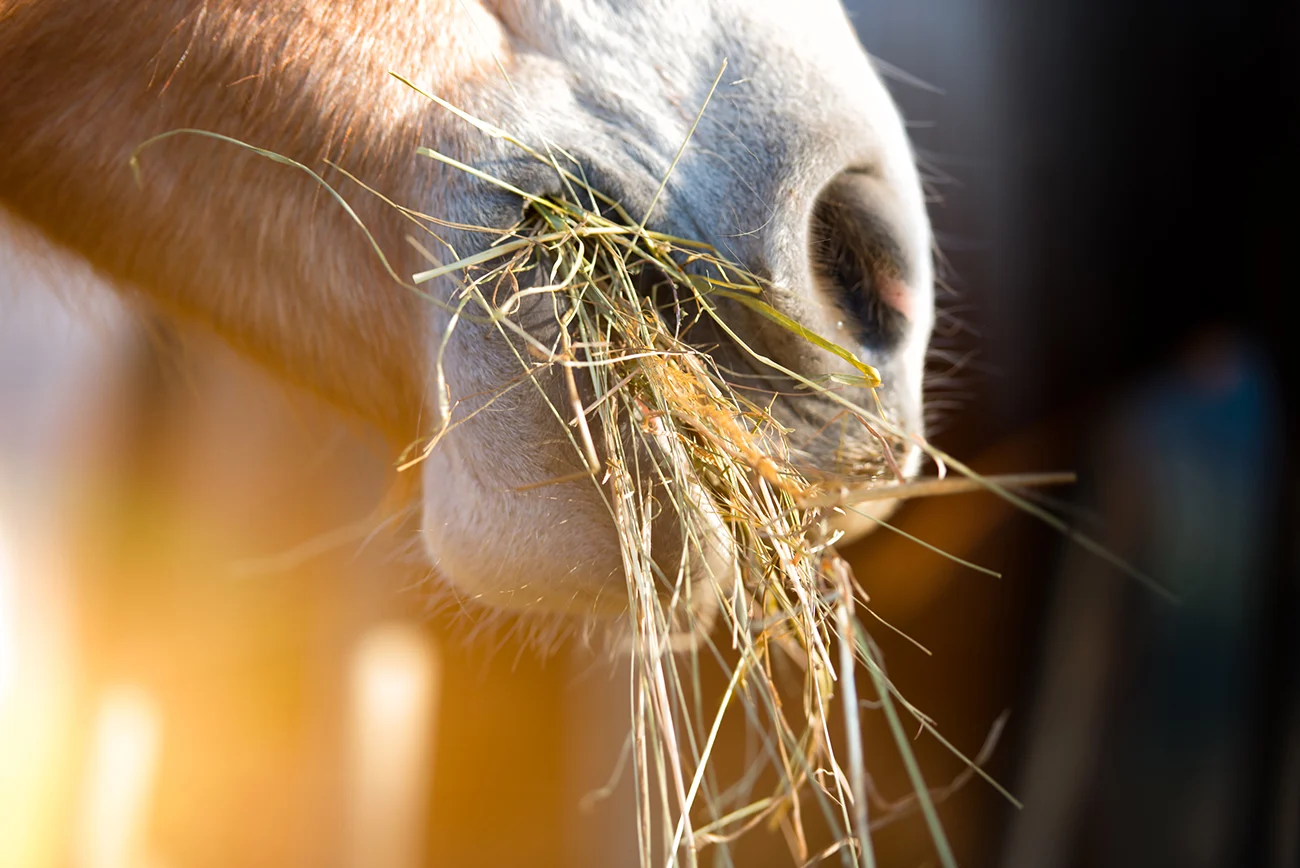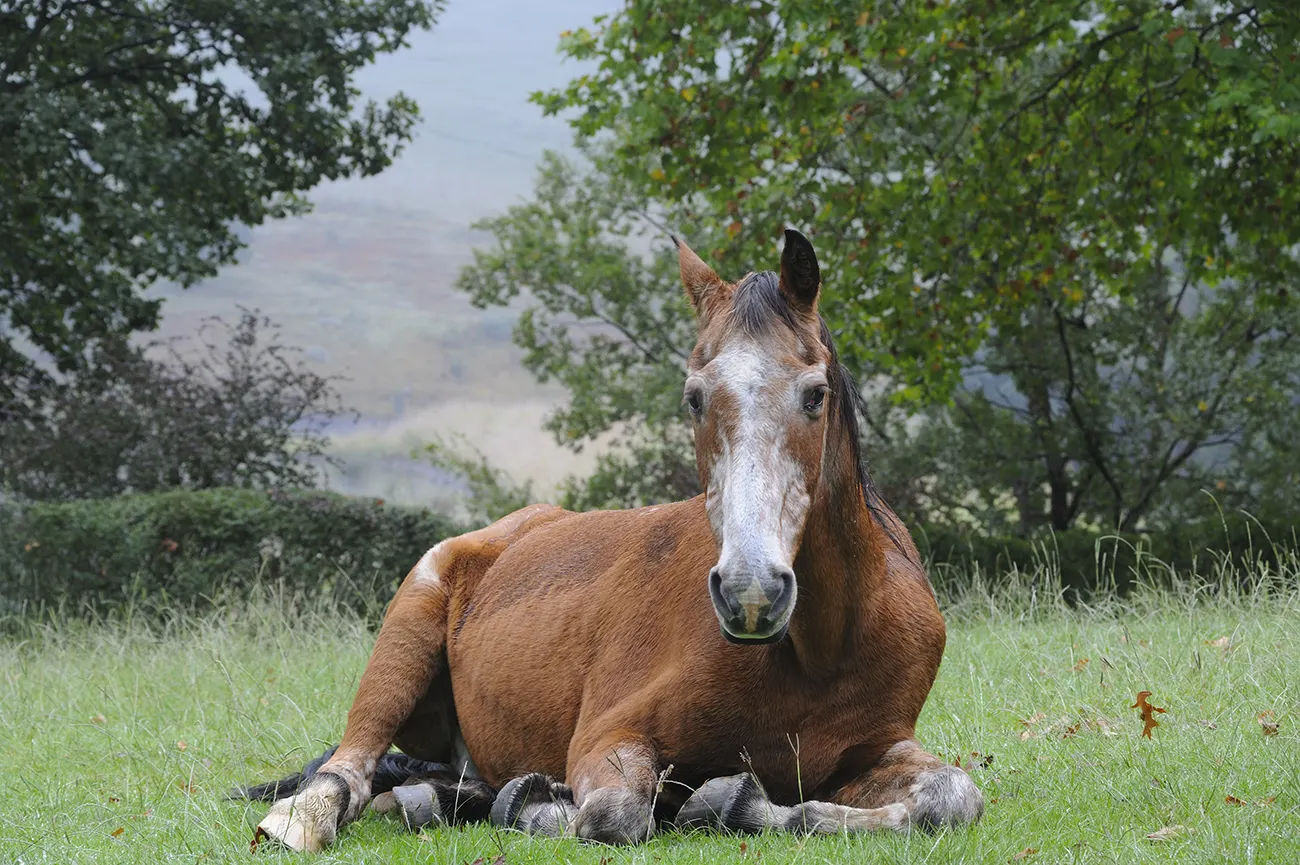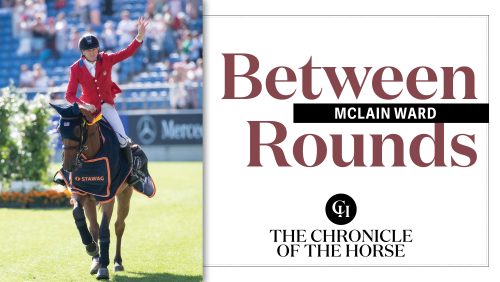Thanks to advancements in nearly every aspect of equine health, it is increasingly common for horses to not just live but thrive well into their late 20s and early 30s. Although some of these animals will need only minimal lifestyle changes to keep them happy and healthy, most will ultimately require some type of age-related adjustments to their management and care, and it is important caretakers understand some of the most common concerns. Once a horse begins experiencing age-related challenges, they are considered “geriatric” by the veterinary community, regardless of their chronological age.
Broadly speaking, caring for geriatric horses will require greater attention to managing dental health, ensuring nutritional needs are being met, maintaining a healthy body condition, and watching for symptoms of several common endocrine disorders. Many times, these issues intersect, and when a horse begins to experience challenges in one area, related problems can follow. Additional concerns include arthritis and pain management, housing considerations, and herd stress.
Increased Need For Dental Care
Equine teeth continuously erupt throughout the course of a horse’s life, meaning sometimes they quite literally outlive the amount of tooth available in their jaw.
Over time, this can cause an array of dental problems, including loose, cracked or lost teeth; a dramatic reduction in available grinding surface on the molars; and the development of diastemata, spaces between the teeth that can become packed with feed particles leading to secondary infections. Geriatric horses can also develop a painful condition called equine odontoclastic tooth resorption and hypercementosis (EOTRH), a progressive syndrome affecting the incisors which may warrant their removal.
Not only can these dental challenges be painful, they also may impede a horse’s ability to safely ingest and chew his food. Partially or incompletely chewed food can result in esophageal choke, impactions in the gut, and poor absorption of nutrients from the feed. Routine dental care can help to mitigate some of these concerns.

“Not every horse is blessed with the same good dentition as the next,” said Toby Pinn-Woodcock, DVM, DACVIM, associate clinical professor at Cornell University’s College of Veterinary Medicine in Ithaca, New York. “They need at least one, ideally sedated, oral exam with a speculum annually to get a really good look at their mouth, all the way to the molars in the back. Some horses might need additional monitoring the older they get, so we can ensure they are as comfortable as possible when prehending and chewing food.”
Despite routine care, geriatric dental issues may eventually become significant enough that the animal can no longer adequately chew traditional sources of fiber, such as long-stemmed hay.
“Older horses, even if they have bad teeth, can often do well while grazing, but the minute the grasses dry up, or you are having to feed hay, or if you see them making quids and spitting them out, you may need to seek alternatives,” said Kathleen Crandell, Ph.D. a nutritionist with Kentucky Equine Research in Versailles, Kentucky. “When they can’t chew well enough to break down the grass, then it’s not going to do them any good because the enzymes and bacteria that digest the grass fiber and cell contents for them can’t do their job efficiently when material isn’t broken down into a small enough particle size.”
Chopped forages are one option for these animals, as their shorter fiber length requires less chewing. Although chopped hay is commercially available, some owners save money by using a leaf mulcher to chop hay flakes themselves.
Hay pellets or hay cubes, usually made of timothy, alfalfa, or a blend, can also be used to replace flaked hay, on a pound per pound dry matter basis, but must be thoroughly and completely soaked before feeding.
“These products can be intermediate steps for horses that aren’t ready to be on pelleted diets only, but need some help due to reduced dentition,” said Emily Berryhill, DVM, DACVIM, assistant clinical professor of equine internal medicine at the University of California-Davis School of Veterinary Medicine in Davis, California.
Once soaked, pelleted and cubed hays magnify in volume; one significant drawback to feeding them is that the horse’s ration will need to be split into at least three or four meals per day, which can be challenging to achieve in some situations. Further, mashes can ferment if left out too long, and it may be necessary to refresh them throughout the day.
Pinn-Woodcock notes that for an extremely old animal that has already lost most of their teeth, the sedation required for a thorough oral exam may be contraindicated as not all geriatric horses tolerate sedation well. Your veterinarian, knowing your horse, will have to make a judgement about whether sufficient benefit can be gained from the procedure.
Feeding The Geriatric Equine
Some erroneously believe that older horses will always have a thinner body condition. But while experts acknowledge some geriatric horses do experience a reduction in nutrient absorption capacity, there is always a cause—and often, it can (and should be) identified and addressed. After managing any dental concerns, a close evaluation of the horse’s diet should be next.
“When I’m trying to formulate a diet plan for a senior horse, the things I would take into account include if the horse is still in work, the horse’s dentition and whether it can still chew forage, and whether the horse has any other health concerns,” said Pinn-Woodcock. “Then I would consider what part of the country the horse lives in, because depending on where you are, all horses—whether they are geriatric or not—might be at risk for certain deficiencies.”
Almost every commercial grain manufacturer will have one (or more) feeds in their line formulated specifically to meet the needs of senior horses. Most senior feeds are processed in such a way that they are both easy for the horse to digest and easy for an owner to turn into a mash. However, it is critical to carefully review both the feed label, which details the product’s guaranteed nutritional analysis, as well as the feeding instructions, to determine if the formulation is the best choice for a specific animal and management system.
ADVERTISEMENT
“We can do things to the feed stuff itself to improve the bioavailability of nutrients,” said Crandell. “For example, grain can be processed in a way that makes it more easily digestible, such as steam flaking, micronizing or grinding for pelleting or extruding. All of these processes improve digestibility to some degree.”
Feeds labeled as “complete” rations, when fed at the recommended rate, are intended to wholly meet an animal’s nutritional needs, including fiber. This makes them an excellent choice for geriatrics who cannot or should not have hay. Other senior feeds are meant to complement a ration that still includes forage (including in the form of soaked pellets or cubes) and therefore should be fed at a lower rate than a complete feed. It is critical that managers know the difference, as failure to feed each product at the correct rate is a common cause of nutrient deficiency in geriatrics.
Feeding a commercially formulated senior feed is a smart choice for many situations—particularly because the nutritionists creating these products are pulling from the latest research. For example, it was formerly believed that older horses struggled to absorb protein, and senior feeds tended to be higher in this nutrient. But new studies have revealed that it is the quality and bioavailability in the diet of specific essential amino acids (the building blocks of protein) that is most important.
“Unless a senior horse has some reason for damage in the digestive tract, such as heavy parasitic infections, they probably don’t need more dietary protein,” said Crandell. “There are some amino acids the body can make itself, so there is much more focus on making sure the essential ones—which they cannot make—are present in the diet.”
Increasing dietary fat (up to 12 to 15 percent of the total diet) is a good management strategy for older horses struggling to maintain weight. Fat can be an expensive ingredient to supplement, so experts recommend using highly digestible forms, such as soybean or rice bran oil. Fat is also an excellent source of energy, and is safer for horses with metabolic concerns than carbohydrates (more on this later).
As with any class of horse, fiber should still comprise the bulk of your geriatric horse’s diet. Again, changes to dentition and the incidence of metabolic disease may impact your horse’s ability to safely consume enough forage to meet this requirement. Senior feeds often utilize highly digestible forms of fiber, such as alfalfa meal, beet pulp, soy hulls or even coconut meal.
Geriatric horses can sometimes be quite particular about their feed, and palatability is an important consideration. It may be necessary to try several different brands of feed to find one that your horse prefers, but be mindful it is still important to make feed changes gradually.

The Metabolic Trio
Perhaps one of the most challenging aspects of managing geriatrics comes from their propensity to develop disorders of the endocrine system. The incidence of pituitary pars intermedia dysfunction, formerly known as equine Cushing’s disease, increases with age.
PPID is often associated with symptoms including muscle wasting; a long, shaggy, hair coat, often slow to shed; increased drinking and urination; temperature regulation challenges; and increased susceptibility to infection. PPID can occur on its own, or in combination with another endocrine disorder, equine metabolic syndrome, which is found in horses of all ages. EMS is associated with obesity, and its effect on the horse is somewhat similar to Type 2 diabetes in humans.
Both PPID and EMS cause insulin dysregulation, a condition where the body doesn’t respond normally to increased insulin in the blood. Unfortunately, horses with insulin dysregulation are at a much higher risk of developing laminitis.
While the cause of the insulin dysregulation differs between the two syndromes, getting it under control is the top priority in managing them. This is usually achieved through a combination of diet, exercise and medication.
For over-conditioned or obese animals, weight loss—achieved through dietary changes and increased exercise, if tolerated—is essential. Additionally, horses with PPID and/or EMS should be fed a ration that is low in non-structural carbohydrates, better known as sugars and starches.
“Non-structural carbohydrates drive insulin release, and so controlling non-structural carbohydrate intake is critical in managing horses with high insulin,” said Berryhill. “Feeding a diet that is low in non-structural carbohydrates, less than 10 percent on average, is important.”
Horses with PPID and/or EMS often cannot tolerate grazing and may need their hay to be soaked and drained prior to feeding to leach off excess sugars. In situations where grazing cannot be avoided, a muzzle is recommended.
Ideally, hay should be tested to determine its NSC value. For obese animals, grain should be eliminated from their diet, if possible; a ration balancer, fed at the recommended rate alongside forage, can ensure they still receive enough vitamins and minerals.
“There are quite a few feeds on the market now that are high fiber and high fat, and low starch and sugar,” noted Crandell. “A horse with PPID or EMS is more sensitive to dietary sugar and starch, so you want to be much more careful with the level of sugar and starch in the diet.”
Unfortunately, once the process of insulin dysregulation begins, in some horses it can be a hard cycle to break. For obese animals, medications such as levothyroxine, ertugliflozin and metformin can help to boost the metabolism and encourage weight loss. Horses with PPID should be treated with pergolide, which helps to stabilize the increased levels of adrenocorticotropic hormone (ACTH) associated with this condition that in turn leads to the increased insulin in the blood.
ADVERTISEMENT
“It is the persistently high insulin in these syndromes that is toxic to the laminae in the horse’s foot and results in the development of laminitis,” said Pinn-Woodcock. “The best thing to do is prevent it, because once a horse has had an episode of laminitis, it is not uncommon for it to recur intermittently.”
Other Age-Related Concerns
Geriatric animals of all species have bodies with more miles on them, so to speak, and therefore they are more prone to acquiring conditions related to wear and tear, such as osteoarthritis, requiring long-term management.
“The degree of arthritis older horses develop is somewhat reflective of what they’ve done before and somewhat genetic,” said Pinn-Woodcock. “Owners need to work with their veterinarian to determine whether the horse requires just a systemic anti-inflammatory on an as-needed or daily basis, or other therapeutics, to manage arthritis pain.”
Arthritis in the neck or jaw can make eating in certain positions painful; managers may have to experiment with different feeders to find the best option for an individual horse.
“They have been good to you, so you want to do what you can to make them comfortable in their last few years of life.”
Dr. Kathleen Crandell
Another common geriatric condition is the development of certain types of cancer, such as melanoma in gray horses and squamous cell carcinoma on non-pigmented skin. Cancers are the result of genetic mutations at the cellular level and are best addressed when they are first identified.
“Every animal is exposed to ‘insults’ on our cells that may cause mutations, and as animals age, they have essentially been exposed to more insults with the passage of time,” said Berryhill. “Factors that promote tumor development include UV damage, local inflammation at a site—such as from a burn or chronic infection—as well as some viruses, genetics and other environmental influences.”
Finally, geriatric horses may need adjustments to their living situation to accommodate their evolving needs. For example, arthritic changes can make managing pastures with hilly or rocky terrain more difficult, necessitating relocation to a flatter area. Geriatrics may require access to a location with deeper or more supportive bedding to ensure they lay down to rest. Further, some animals—particularly those in thinner body condition or with PPID—may not thermoregulate as well as they did when they were younger, meaning they may require blanketing in winter and increased access to shelter in all conditions. Lastly, although geriatrics still need to be around other horses, herd dynamics must continuously be evaluated to ensure seniors have sufficient access to shelter, feed, water and other resources.
“As horses age, they often fall to the bottom of the hierarchy in a herd,” said Crandell. “Sometimes, they just don’t have the will to fight for their food. If you have them in a group, you need to be aware of whether they are getting their fair share, or you may need to separate them out for feeding.”
Geriatrics eating a primarily mash diet may also require more time to eat, meaning that inclusion in a large herd setting is simply no longer feasible.
“If the average 1,000-pound horse is eating, at a minimum, 10 to 20 pounds of hay per day, and you are now feeding that either as soaked hay cubes, pellets, a complete feed, or some combination—that is quite a lot to get into a horse in the course of a day in the form of mashes,” said Pinn-Woodcock. “Do you have a management system that supports that? Often seniors need to be given time to eat it slowly, or they pick on it all day long.”
“In general, people should be aware that just because a horse ‘has never had a problem’ in the past does not preclude them from needing adjustments to their housing or feeding as they age,” added Berryhill. “Age is not a disease, but, just like in other species, modifications are needed to support a high quality of life as needs change.”
New research, more effective therapies and better overall attention to long-term health means that we can now reasonably expect more horses than ever to live into their geriatric years. Owners and caretakers should be prepared to accommodate the unique needs of these animals.
“They are not just pets, they are friends, so it is important to do what you can for them,” said Crandell. “They have been good to you, so you want to do what you can to make them comfortable in their last few years of life.”
This article originally appeared in the March 2025 issue of The Chronicle of the Horse. You can subscribe and get online access to a digital version and then enjoy a year of The Chronicle of the Horse. If you’re just following COTH online, you’re missing so much great unique content. Each print issue of the Chronicle is full of in-depth competition news, fascinating features, probing looks at issues within the sports of hunter/jumper, eventing and dressage, and stunning photography.














